Inhibitory Activity of Isoquercetin and Quercetin-4'-Glucoside on the Drug Targets of Staphalococus aureus Causing Bovine Mastitis - An In silico Approach
B Sruthy1, MS Latha1* and Sherly P Anand2
1Department of Chemistry, Sree Narayana College, India
2Department of Zoology, TKMM College of Arts and Science, India
Submission: February 23, 2018; Published: March 27, 2018
*Corresponding author: MS Latha, Department of Chemistry, Sree Narayana College, India, Tel: 9400648068; Email: lathams2014@gmail.com
How to cite this article: B Sruthy, MS Latha, Sherly P Anand. Inhibitory Activity of Isoquercetin and Quercetin-4'-Glucoside on the Drug Targets of Staphalococus aureus Causing Bovine Mastitis - An In silico Approach. Glob J Nano. 2018; 4(1): 555626. DOI 10.19080/GJN.2018.04.555626
Abstract
Bovine mastitis is the inflammation of mammary glands of cattles leading to decrease in milk production and cause huge economic losses in diary industry. Among the mastitis causing pathogens, Staphalococus aureus bacterial infections are most common. Extracellular matrix binding protein and monofunctional glycosyltransferase inhibitors are the most potent drug molecules against Bovine mastitis caused by Staphalococus aureus bacteria. The affected animals treated with current extracellular matrix binding protein and monofunctional glycosyltransferase inhibitors are antibiotics with severe side effects. Crude extract of locally available plants in the Amaryllidacea family is known to be very effective against mastitis. Glucoside derivatives of Quercetin are the major flavonoids in Amaryllidacea family.
The docking study of these flavanoids using Schrodinger suit v.9.2 showed their inhibitory activity against the target proteins. The Crystal structure of the target protein was retrieved from Protein Data Bank. (PDB ID: 4KJM, 3HZS and 3VMQ) and the structure of the ligand molecules were collected from PUB CHEM NCBI. Isoquercetin and Quercetin-4'-glucoside shows better docking results compared to the commonly used antibiotic, pirlimycin hydrochloride. This study has revealed the superiority of Quercetin glucosides over the conventional drug as extracellular matrix binding protein and monofunctional glycosyltransferase inhibitors and it sets the necessity of further in vivo study of this compounds in future for the development of more promising drugs for Bovine mastitis.
keywords: Extracellular matrix binding protein; Monofunctional glycosyltransferase; Staphalococus aureus; Bovinemastitis; Docking; Extra precision
Introduction
Bovine mastitis is an inflammation to the mammary gland of cattle [1]. Causative of the inflammation include bacteria, virus and non bacterial pathogens. The infectious agents invade the udder through teat canal and multiply rapidly. Then due to an inflammatory reaction tissues get damaged [2]. Among the mastitis causing pathogens, Staphalococus aureus bacterial infections are very common. Staphalococus aureus is a gram positive round shaped bacterium. Bovine mastitis reduces the quantity of casein, lactoferrin and potassium in milk. As the major protein, casein in milk deteriorates; the calcium level in milk also decreases. During processing and storage also the milk proteins undergo deterioration [3]. Milk from affected animals show very high somatic cell count which lowers the quality of milk [4]. Hence, Bovine mastitis causes severe economic losses in diary industry [5]. Current treatment of mastitis includes antibiotic therapy. But the residues of antibiotics remain in milk causes severe side effects. And the antibiotic resistance developed in bacteria due to long series therapy decreases the effectiveness of the drug [6]. Pirlimycin hydrochloride (Pirsue) is the most common drug used against Bovine mastitis [7].
Extracellular matrix binding protein and monofunctional glycosyltransferase are two excellent drug targets for the prevention of mastitis [8]. In order to be infectious, bacteria's had surface proteins of specific affinity for components in the extra cellular matrix. These proteins are called extracellular matrix binding proteins or receptions [9]. It has been reported that extracellular matrix binding protein of Staphalococus aureus are required for adhesion to and invasion of bovine mammary gland [10]. So, inhibition of which blocks the adherences capacity of the bacteria. Monofunctional glycosyltransferase are cell wall associated drug targets (PDB ID: 3HZS and 3VMQ) Inhibition of this protein results in bacterial cell lysis [11,12]. Current extracellular matrix binding protein and monofunctional glycosyltransferase inhibitors are antibiotics with decreased efficacy.
Glucoside derivatives of Quercetin are plant flavonoids possess enormous therapeutic applications [13]. The presence of sugar moiety increases its bioavailability. The present study focuses on the inhibitory activity of glucoside derivatives of Quercetin and Quercetin-4'-glucoside targeting the excellent drug targets in Staphalococus aureus causing Bovine mastitis. The in silico analysis using Schrodinger maestro module showed the binding interactions of these molecules with the target protein. Comparison of the results with the most commonly used commercially available drug reveals its potential anti mastitis activity.

Methodology
The docking studies were performed with Schrodinger Software Suit, LLC, New York, 2012. The 3D crystallographic structure of the target extracellular matrix binding protein (PDB ID:4KJM) was downloaded from Protein Data Bank [14] The protein complex was prepared by protein preparation wizard after pre-processing in Maestro 9.3.5 Version Schrodinger Software [15]. The minimization of the protein complex was continued using Optimized Potential for Liquid Simulations force field [16]. The 2Dstructures of the glucoside derivatives of quercetin and pirlimycin hydrochloride were imported from the project Table 1. These ligands were minimized and geometrically refined using Lig Prep module [17]. The extra precision (XP) mode of docking was used to find the interaction between the active site of extracellular matrix binding protein and the ligand molecules using Glide of the Schrodinger Software Suite [18].
Results and Discussion
Structure of the ligands (Figures 1-3) .
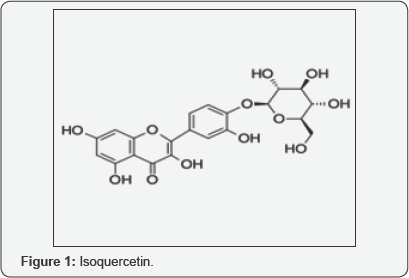
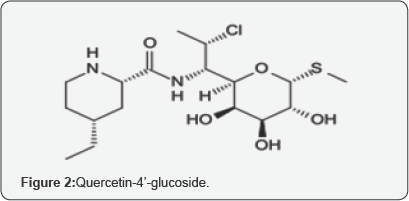

i. 3D docking images of ligands with 4KJM (Extracellular matrix binding protein) (Figures 4-6).
ii. 3D Docking images of the ligands with 3HZS (Monofunctional glycosyltransferase) (Figures 7-9).
iii. 3Ddocking images of ligands with 3VMQ (Monofunctional glycosyltransferase) (Figures 10-12).

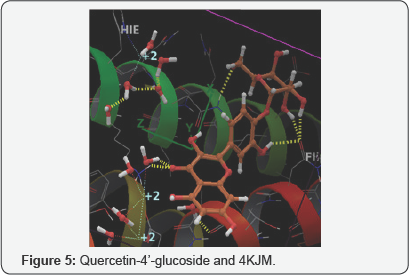

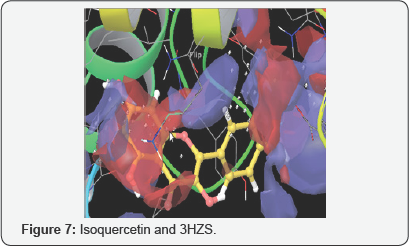
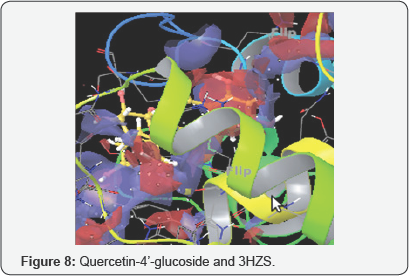
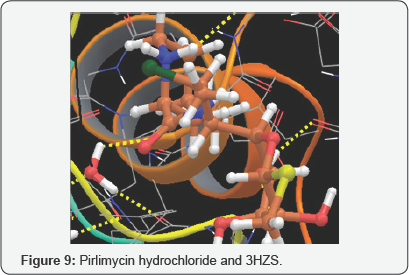
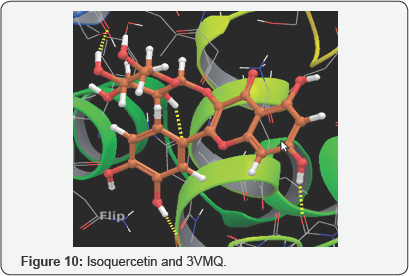

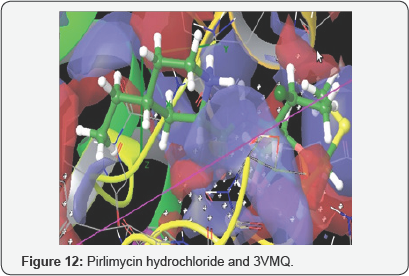
iv. 2D interaction of ligands with 4KJM (Figures 13-15).
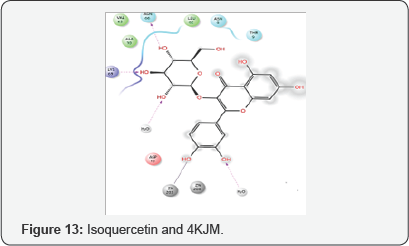
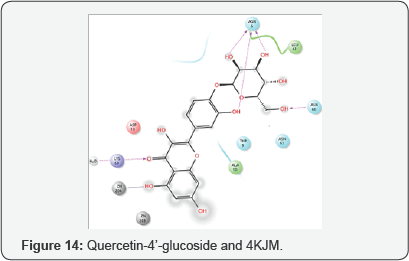
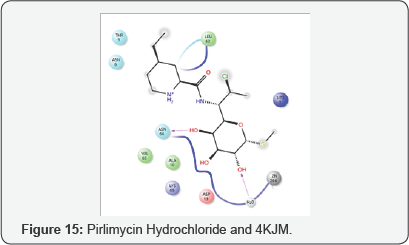
V.2D interaction of ligands with 3HZS (Figures 16-18).
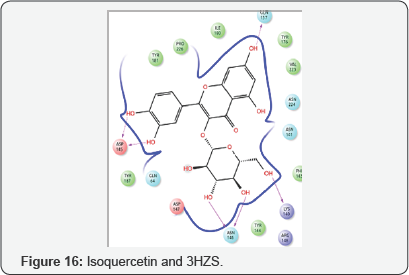

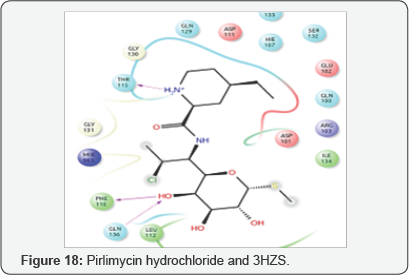
Vi. 2D interaction of ligands with 3VMQ (Figures 19-21).
From the docking results, it has been observed that the glucoside derivatives of quercetin possess excellent inhibitory activity towards all the three target proteins compared to the commercially available drug. Isoquercetin forms four hydrogen bonds with the active binding site of the extracellular matrix binding protein. ASN 66 and LYS 69 amino acid residues in the binding pocket of the target protein forms hydrogen bonds with hydroxyl groups in the ligand. Two water molecules present in the protein also forms hydrogen bonds with hydroxyl groups in the isoquercetin molecule. In addition to that there is a metal coordination between the metal Zn 203 and the ligand. All these interaction contributes the necessary binding energy for inhibitory action. Quercetin-4’-glucoside forms five hydrogen bonds with the active site of the target Extra cellular matrix binding protein. Hydroxyl groups in the ligand forms four hydrogen bond with 6ASN and 66ASN amino acid residues. Another hydrogen bond is formed between a nearby water molecule in the target protein and the ketogenic oxygen of the ligand molecule. The metal Zn 204 in the protein forms a metal coordination with hydroxyl group in the ligand. Two hydroxyl groups in Pirlimycin hydrochloride forms hydrogen bonds with 66ASN amino acid residue and a nearby water molecule.
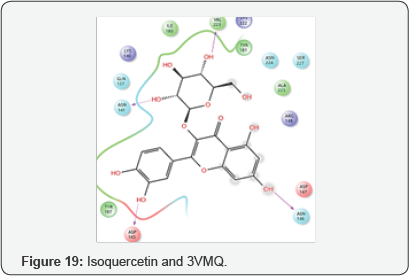
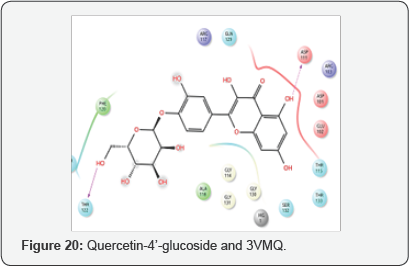
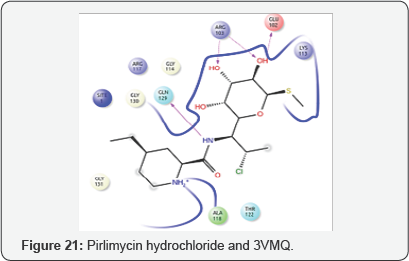
Staphalococus aureus attach to the extracellular matrix of the mammary gland through the extracellular matrix binding protein (PDB ID: 4KJM) and then colonize and multiplies. The 4KJM inhibitors, Isoquercetin and Quercetin-4,-glucoside blocks the active site of the protein and causes the detachment of bacteria from the extracellular matrix. These inhibitory ligands have better docking scores and glucose moiety in isoquercetin and quercetin-4'-glucoside are responsible for the increased inhibitory action compared to the commercial drug.
Monofunctional glycosyltransferase (PDB ID: 3HZS and 3VMQ) are a class of another excellent drug targets in Staphalococus aureus causing Bovine mastitis. Three hydroxyl groups in Isoquercetin forms hydrogen bond with the backbone amide nitrogen atoms of 146ASN and 140 LYS of 3HZS. There is also three side-to-side hydrogen bonding interactions between hydroxyl groups in the ligand molecule and 137 GLN and 145ASP Quercetin-4'-glucoside forms four side-to-side hydrogen bonds with 66ASN, 6ASN, 6TYR. Pirlimycin hydrochloride forms two side-to-side hydrogen bonding interactions 136GLN and PHE. The N atom in the ligand also forms a back bone hydrogen bonding interaction with the 115THR of 4HZS.
From the docking score, it is evident that the glucoside derivatives of Quercetin are better inhibitors than the commercial drug. Isoquercetin possess two side-to-side hydrogen bonding interactions with 141ASNand 145ASP of Monofunctional glycosyltransferase, 3VMQ. There is two more hydrogen bonds between the ligand and 146ASN and 223VAL. Quercetin-4'-glucoside forms a side-to-side hydrogen bond with 111ASP and another with nitrogen atom of the amide group of 122THR. Pirlimycin hydrochloride forms four hydrogen bonds with 102GLU, 103ARG, 129GLN and 103ARG (side-to-side) of the monofunctional glycosyltransferase 3VMQ. Glycosyltransferase are associated with the bacterial cell wall biosynthesis. Inhibition of these essential targets results in bacterial cell lysis. Isoquercetin and Quercetin-4'-glucoside shows better docking than the commonly used drug against mastitis.
Conclusion
The glucoside derivatives of Quercetin (Isoquercetin and Quercetin-4'-glucoside) shows potent inhibitory activity towards the Extracellular matrix binding protein and monofunctional glycosyltransferase compared to the most common commercially available drug. By inhibiting Extracellular matrix binding protein, isoquercetin and Quercetin-4'-glucoside exterminate the adhesion capacity of the protein to the extracellular matrix of Bovine mammary gland which results in the detachment of bacteria from the gland or bacterial death. Monofunctional glycosyltransferase are essential for bacterial cell wall biosynthesis. Glucoside derivatives of Quercetin can act as an inhibitor of transglycosylation step which results in bacterial cell lysis. That is Isoquercetin and Quercetin-4'-glucoside inhibits both the indispensable drug targets in Staphalococus aureus which attributed to two different mechanisms. Thus, the antimastitis activity of plants in the Amaryllidacea family is due to the phytochemicals Isoquercetin and Quercetin-4'-glucoside. This study reveals the importance of glucoside derivatives of Quercetin in the treatment of mastitis by an in silico approach and sets the scope of further in vitro and in vivo analysis for the development of new promising drugs for mastitis.
References
- https://en.wikipedia.org/wiki/mastitis_in_diary_cattle.
- Lammers A, Piet JM, Nuijten HE, Smith (1999) The fibronecting binding proteins of Staphalococus aureus are required for adhesion to and invasion of bovine mammary gland cells. FEMS Microbiology letters 180: 103-109.
- Harmon RJ (1994) Physiology of mastitis and factors affecting somatic cell count. J Dairy Sci 7(77): 2103-2112.
- Kandasamy S, Green BB, Benjamin AL, Kerr DE (2011) Between-cow variation in dermal fibroblast response to lipopolysaccharide reflected in resolution of inflammation during Escherichia Coli mastitis. J Dairy Sci1 2(94): 5963-5975.
- Department of Animal Science (2003) Mastitis in Dairy Cows. MacDonald Campus of McGill University, Quebec, Canada.
- Andrea F, Carly S, Kristina K, Ralf E, Stefan M, et al. (2010) Characterisation of methicillin-resistant Staphalococus aureus ST 398 from cases of bovine mastitis. Journal of Antimicrobial Chemotherapy 65(4): 619-625.
- https://www.zoetisus.com/products/dairy/pirsue.aspx
- Reena JP, Prashant D, Kunjadia CGJ, Anju PK (2015) Identification of purative drug targets in mastitis causing Staphalococus aureus by insilico approach. International Journal of Pharmacy and Pharmaceutical sciences 7(9): 496-502.
- Kronvall G, Jonsson K (1999) Characterization of Ehp, a secreted complementary inhibitory protein from staphalococus aureus. J mol Recogn 282(41): 30051-30061.
- Sutra LB, Poutrel B (1994) Virulence factors involved in the pathogenesis of bovine intramammary infections due to Staphalococus aureus. J Med Microbiol 40(2): 79-89
- Heaslet H, Shaw B, Mistryand A, Miller AA (2011) Monofunctional Transglycosylase are not essential for staphalococus aureus cell wall synthesis. J Struct Biol 193(10): 2549-2556.
- Huang CY, Shih HW, Lin LY, Tien YW, Cheng TJR, et al. (2012) Crystal structure of Staphylococcus aureus transglycosylase in complex with a lipid II analog and elucidation of peptidoglycan synthesis mechanism. Proc Natl Acad Sci 109(14): 6496-6501.
- Maria R, Carmela S, Idolo T, Stefania B, Gian LR (2012) The Flavonoid Quercetin in disease prevention and therapy. Biochemical Pharmacology 83(1): 6-15.
- A Structural View of Biology (2017) PDB, USA.
- Schrodinger (2012) LLC, New York, USA.
- Jorgenson WL, Maxwell DS, Tirado RJ (1996) Development and testing of the OPLS All-atom Force field on Conformational Energetics and properties of Organic Liquids. J Am Chem Soc 118(45): 11225-11236.
- Lig Prep (2012) Schrodinger. LLC, New York, USA.
- Glide version 5.8 (2018) Schrodinger. LLC, New York, USA.






